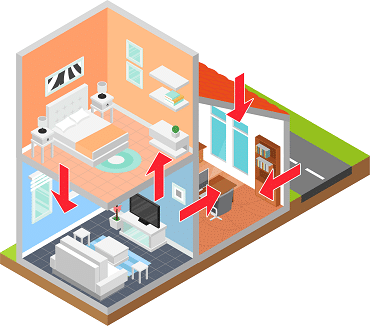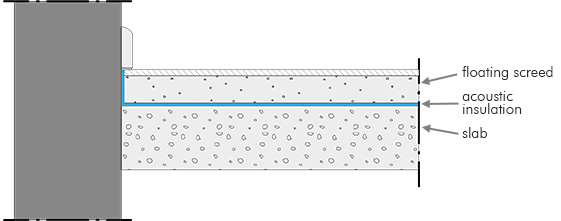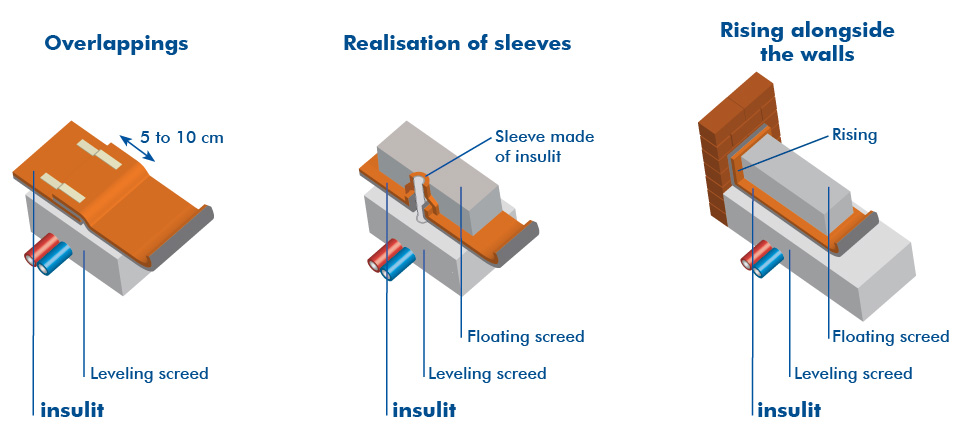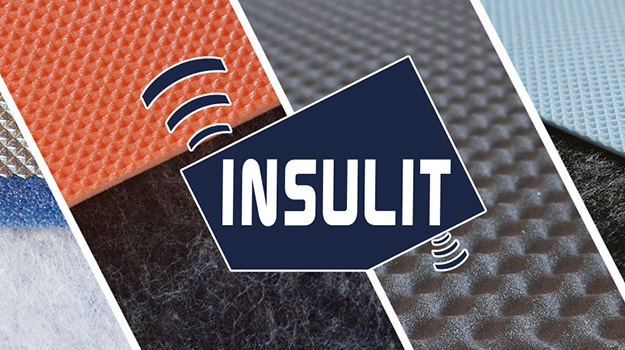How does it work?

General principles

Noise transmission in a building
Inside a building intended for housing, three types of acoustic nuisance can be distinguished:
– Noise from technical installations (lifts, ventilation, boilers, etc.).
– Airborne noise (speech, television, music, etc.)
– Contact, impact, or shock noise (people walking, falling objects, chairs, etc.).
If it is not stopped, the acoustic wave propagates throughout the building, either through the air or through vibrating materials.
By definition, airborne sound propagates through the air, but it can also vibrate walls or floors, becoming mechanical noise.
Impact noise has a considerable force: the impact directly makes the material vibrate (concrete, bricks, steel, plaster, glass, etc.).
The sound wave will propagate at different speeds depending on the elements it passes through. If a sound travels 340 m/sec in air, it will reach the speed of 3500 m/sec in concrete or 6000 m/sec in steel. In these denser materials, the attenuation rate is much lower than in the air. For this reason, impact noise can be heard from very distant parts of the building, whereas no airborne noise can be heard from those same places.
It can also be added that, without insulation, impact noise generated on one floor will have practically the same intensity on the lower floor. Everyday noise can therefore very quickly become a calamity.
Increasing the mass of the partitions will limit the transmission of airborne sound, but will only be weakly effective against the transmission of contact noise that passes through these materials.
The floating screed, the solution to contact noise
To avoid this transmission of contact noise, two techniques are possible:
- Avoiding impact at the source (laying felt pads, thick solid carpets, walking in socks, etc.).
- Creating a floating screed.
The floating screed creates a break between the impact (transmitter) and the room (receiver). To do this, the floor on which you are walking must be completely disconnected from the building. The floating screed is the only effective solution between two dwellings, to comply with the acoustic standard in force

A floating screed consists of a hard element (the screed) placed on a spring (the underlay) laid on a hard element (floor slab, concrete slab, floor, etc.). Under the action of a sound wave, the floating screed must be able to vibrate and have no point of contact with the structure of the building. This total uncoupling also applies to the elements that would themselves be in contact with the building (drainage pipes, electrical ducts, fasteners that pass through the screed, etc.).

The acoustic underlay
Uncoupling of the floating screed is achieved by installing an acoustic membrane.
The ideal underlay must:
– have the best reduction of weighted impact sound pressure level (∆Lw);
– have the lowest dynamic stiffness (s‘t);
– have the lowest creeping, i.e. it should not crumble over time to always offer the same performance;
– be flexible to provide a good spring;
– be tear-resistant for the installation;
– be light and easy to install;
By choosing an insulation material from the insulit range, you can be sure that you meet the criteria for insulating floors against impact noise. We invite you to discover the unique insulit quality.


